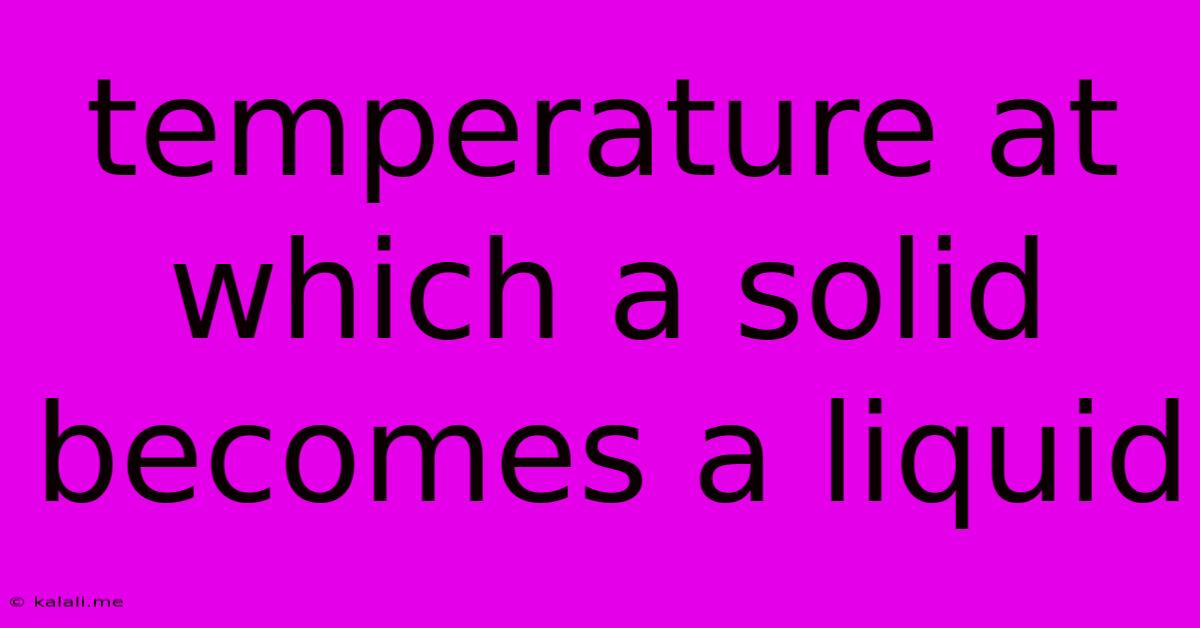Temperature At Which A Solid Becomes A Liquid
Kalali
Jun 14, 2025 · 3 min read

Table of Contents
The Melting Point: When Solids Become Liquids
The transition of a solid substance into a liquid state is a fundamental concept in chemistry and physics, crucial for understanding various natural phenomena and industrial processes. This fascinating transformation occurs at a specific temperature known as the melting point, a key physical property of every solid material. This article delves into the intricacies of this phase transition, exploring the factors that influence melting points and the scientific principles behind this change of state.
The melting point, sometimes referred to as the liquefaction point, is the temperature at which a solid turns into a liquid at atmospheric pressure. At this temperature, the kinetic energy of the molecules within the solid overcomes the attractive forces holding them in a fixed crystalline structure. This allows the molecules to break free from their rigid arrangement and move more freely, characteristic of the liquid state. It's important to note that this transition isn't instantaneous; it's a process that requires heat energy to be absorbed. This absorbed energy, known as the latent heat of fusion, is used to break the intermolecular bonds holding the solid together.
Factors Affecting the Melting Point
Several factors influence the melting point of a substance:
-
Intermolecular Forces: The strength of the attractive forces between molecules (e.g., van der Waals forces, hydrogen bonds, dipole-dipole interactions) significantly impacts the melting point. Stronger intermolecular forces require more energy to overcome, resulting in a higher melting point. For instance, substances with strong hydrogen bonds, like ice, have relatively high melting points compared to those with weaker van der Waals forces.
-
Molecular Weight: Generally, larger molecules with higher molecular weights have higher melting points. This is because larger molecules have more surface area for intermolecular interactions, leading to stronger attractive forces.
-
Crystalline Structure: The arrangement of molecules in the solid's crystalline structure also affects the melting point. A well-ordered, tightly packed structure generally requires more energy to break apart than a less ordered structure. Polymorphism, the ability of a solid to exist in multiple crystalline forms, can lead to different melting points for the same substance.
-
Pressure: While usually negligible, pressure can influence the melting point. For most substances, increasing the pressure increases the melting point. However, water is an exception; increased pressure lowers its melting point. This anomalous behavior is due to the unique structure of ice, where water molecules are less densely packed than in liquid water.
-
Impurities: The presence of impurities in a solid can lower its melting point. This phenomenon is known as freezing point depression, and it's a colligative property, meaning it depends on the concentration of impurities, not their identity. This principle is utilized in various applications, such as de-icing roads with salt.
Applications of Understanding Melting Points
Understanding melting points is crucial in various scientific and industrial applications:
-
Material Science: Determining the melting point helps in characterizing materials, ensuring purity, and understanding their behavior under different conditions.
-
Chemistry: Melting point determination is a common technique for identifying and purifying substances in the laboratory.
-
Food Science: The melting points of fats and other components influence the texture and properties of food products.
-
Metallurgy: Melting and solidification processes are essential in metal casting and shaping.
The melting point is a fundamental physical property that provides valuable insights into the structure and behavior of matter. Understanding the factors that influence this critical transition point is essential across various scientific disciplines and industrial applications, highlighting the significance of this seemingly simple phase change. Further exploration into phase diagrams and the Clausius-Clapeyron equation can provide a more in-depth understanding of the relationship between temperature, pressure, and phase transitions.
Latest Posts
Latest Posts
-
Which Of The Following Is Not An Effective Study Strategy
Jun 15, 2025
-
How Many Ways Are There To Save A Document
Jun 15, 2025
-
What Is The Difference Between Subordinating And Coordinating Conjunctions
Jun 15, 2025
-
The Meaning Of Words And Sentences Is Called
Jun 15, 2025
-
Device That Converts Mechanical Energy Into Electrical Energy
Jun 15, 2025
Related Post
Thank you for visiting our website which covers about Temperature At Which A Solid Becomes A Liquid . We hope the information provided has been useful to you. Feel free to contact us if you have any questions or need further assistance. See you next time and don't miss to bookmark.